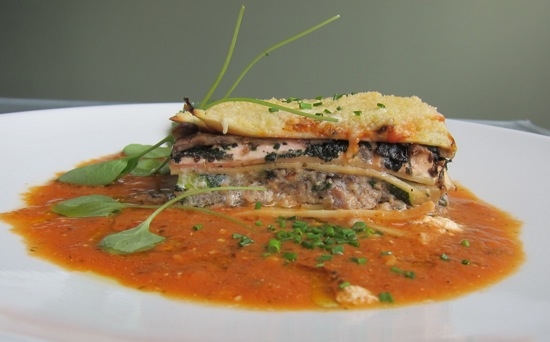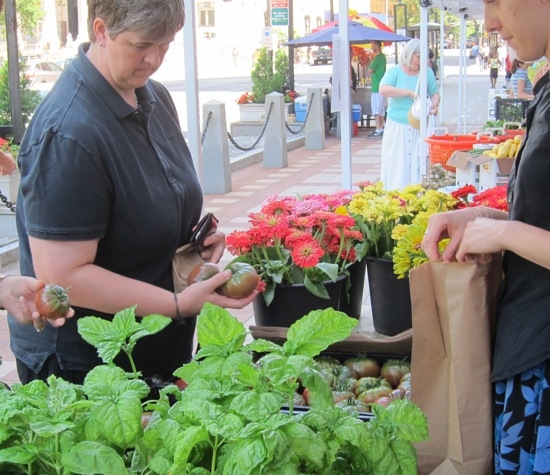The rainbow Swiss chard was grown nearby. Master chef Denise Appel found it at a farmers market by the Green — and by the next night had it stemmed, cooked, squeezed of water, chopped fine, and added to a distinctive lasagna served at a restaurant two blocks away.
The Swiss chard’s journey was part of a summer tradition at Zinc, the restaurant where Appel is the chef: a weekly ritual that starts at farmers markets and ends up with dishes made from local natural ingredients and offered as part of a weekly Wednesday-Sunday “market menu.”
We followed Appel on that journey as she prepared the market menu lasagna, a far cry from your typical pan of baked, layered pasta, sauce and cheese. For starters, it’s not cooked once it’s assembled. Another twist is that the tomato sauce is a garnish, not an integral component. The finished dish is more like a terrine, but with that unmistakable pasta chewiness. (Click on the play arrow to watch Appel prepare it.)
Appel spends lots of time at three of New Haven’s open-air CitySeed farmers markets: in Wooster Square on Saturday, in Westville’s Edgewood Park on Sunday and downtown on Wednesdays.
Many of the fruits and vegetables Appel uses for her recipes come from Urban Oaks Organic Farm in New Britain. The farm grows a lot of heirloom and specialty produce, she said, they wash it well and — most important — they deliver to the restaurant. They also offer meat and dairy products.
In the case of last week’s lasagna, Appel picked up the flavorful chard at the Wednesday market in front of City Hall. It came from Shelton’s Stone Gardens Farm.
She assembled all the ingredients the next day at Zinc, on Chapel Street (click here for the recipe).
Appel started with a plastic wrap-lined pan, since the lasagna would ultimately be inverted for serving. She put down a layer of cooked lasagna noodles, lightly oiled to keep them from sticking together. She used full and half-sheets, although she said traditional store-bought lasagna noodles would work just as well.
The first vegetable layer included the chard, which she drained thoroughly to avoid making a mushy dish. Water is the enemy of a dish like this, she noted, since it both impedes the texture and dilutes the flavor of the vegetables, cheese and herbs. That’s why she doesn’t use tomatoes in the dish; instead, Appel cooked up a smoked tomato sauce to accompany a square of lasagna.
Appel added sliced cooked zucchini, then squirted a generous amount of Liuzzi’s Fino ricotta cheese on top. She laid another sheet of pasta on that, pushing down slightly to spread the cheese and push the air out of the vegetables below.
Then she overlapped edges of the pasta, pressing on the seams with her fingers to seal them. She said all of this work would help the lasagna stay together and let the flavors meld.
“It’s like laying tile,” she said.

Chard and eggplant before they’re added to the dish.
Next came duxelles, a minced mixture of local shiitake mushrooms, with some thyme and other flavorings. She had sliced and cooked the mushrooms, then chopped them finely in a food processor; the mix was spreadable, although not completely smooth. Sliced grilled eggplant went with the mushrooms, topped with more cheese and pasta.
A last layer of veggies included more chard and some sliced green peppers, which Appel roasted over a gas flame, and then a final layer of pasta.
She reflected on the key to a good veggie lasagna: get that water out, and think about how you want the flavors to blend. Everything should be complementary.
“I’d stay away from radishes, and any cabbages,” she said.

When she finished with the layering, Appel trimmed the edges of the pasta and swaddled the top of the dish with the overhanging plastic wrap. It then went into the refrigerator, weighted with a cutting board, overnight. When it was time to serve, she planned to invert the pan, cut the lasagna into squares and heat each serving gently in the oven over a ladleful of smoked tomato sauce.
The dish (pictured) was finished with cheese and some micro greens. It was delicious. It is now gone from the restaurant’s menu — to be replaced by the next dishes inspired by whatever Appel finds at the farmers markets. (Zinc’s website alerts customers to current dishes on the market menu.)
The market menu offers three courses for $29, with a cheese course and specialty cocktail as add-ons. A recent week featured spring garlic and rainbow carrot soup, the lasagna and a yogurt gelato with roasted rhubarb.

Gwyneth K. Shaw Photo
Even if you don’t cook at a restaurant, even if you don’t cook dishes completely from scratch, shopping at farmers markets can enliven home cooking this time of year, advised Appel (pictured). You can find veggies at the height of their flavor and reduce your carbon footprint, since a lot of supermarket produce is shipped from faraway states or countries.
The peak of the summer harvest is still a few weeks off. Appel she suggested loading up on the early-season bounty of lettuces and other greens, from chard to kale to bok choy. Even non-adventurous eaters should go for interesting choices, like radishes and kohlrabi, she said.
“The produce is just so good and so local,” Appel said. “The flavor is so nice.”